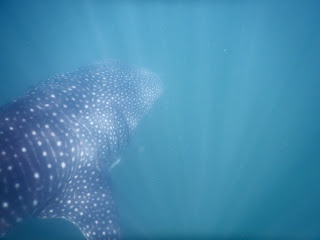”Jump now” the direction comes from our BIO (butanding interaction officer) and we push off the edge of the boat plunging into the sea. I stick close to our guide watching his hand for when he starts to point emphatically. I can’t see anything in the slightly murky blue water but I’ve come to trust that if I direct attention the right way soon I will see the distinct spots of a whale shark approach.
This time, our seventh jump into the ocean, we’re positioned perfectly and the butanding, or whale shark, appears right before us it’s large mouth pointed directly at us. A quick kick of the flippers and I position myself just above it. I watch it’s large graceful form float past then begin a strong stroke to swim with it. I don’t want to stop following it, fascinated by its flat head, visible gills and unique spotted pattern. It is easy to go into an almost trance watching it casually swim below you, at least until you have to fight your way through the next crowd of tourists waiting in its path. Luckily I’m a stronger swimmer then most out here today, and the deceptively lazy float of a whale shark is surprisingly fast, so I get minutes of feeling like I’m alone in the world with this amazing creature.
I finally give up when the whale shark descends deeper into the ocean and becomes a fuzzy outline. Raise my head and look for the boat, climbing back onboard with a sense of exhilaration. There is a huge smile on my face as I settle back on the side of the boat, slipping my fins back on, waiting for the next order to “jump now.” This has been my best day in a long time.
If you want to see the whale sharks I highly encourage you to visit the more ethically and conscientiously run experience in Donsol. They limit the number of boats and tourists allowed out each day to minimize the stress on the whale sharks. They don’t feed them, relying instead on maintaining the environment to their liking. It means you aren’t guaranteed to see a whale shark, but if you come in season the chances are high. We jumped into the water eight times, and I only missed sighting a whale shark one of those times.
This time, our seventh jump into the ocean, we’re positioned perfectly and the butanding, or whale shark, appears right before us it’s large mouth pointed directly at us. A quick kick of the flippers and I position myself just above it. I watch it’s large graceful form float past then begin a strong stroke to swim with it. I don’t want to stop following it, fascinated by its flat head, visible gills and unique spotted pattern. It is easy to go into an almost trance watching it casually swim below you, at least until you have to fight your way through the next crowd of tourists waiting in its path. Luckily I’m a stronger swimmer then most out here today, and the deceptively lazy float of a whale shark is surprisingly fast, so I get minutes of feeling like I’m alone in the world with this amazing creature.
I finally give up when the whale shark descends deeper into the ocean and becomes a fuzzy outline. Raise my head and look for the boat, climbing back onboard with a sense of exhilaration. There is a huge smile on my face as I settle back on the side of the boat, slipping my fins back on, waiting for the next order to “jump now.” This has been my best day in a long time.










































